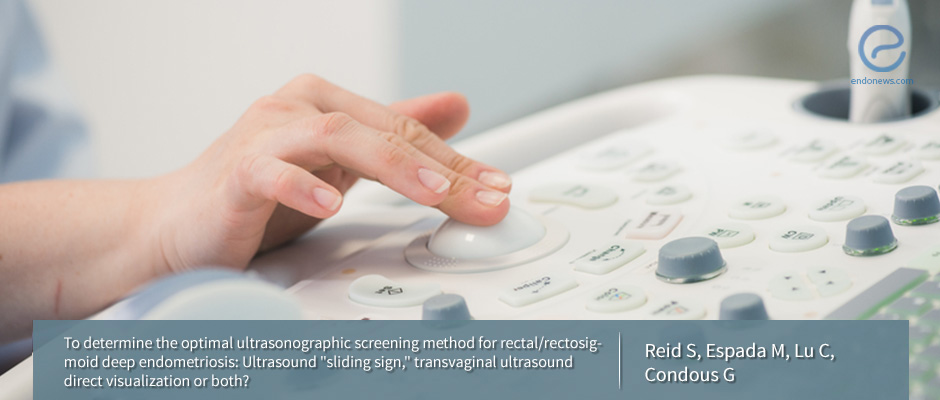The diagnostic value of “sliding sign” and direct visualization of the bowel in rectal/rectosigmoid deep endometriosis
Aug 20, 2018
The combination of “sliding sign” and direct bowel visualization appears to be the best screening method for deep endometriosis.
Key Points
Highlights:
- This multicenter prospective observational study evaluates the diagnostic accuracy of “sliding sign” and/or direct visualization of the bowel with transvaginal ultrasound (TVS) in rectal/rectosigmoid deep endometriosis and emphasizes that the highest accuracy can be provided using the combination of both of the above diagnostic techniques, rather than using only one.
Importance:
- The absence of “sliding sign” should lead the sonographer to make a more detailed assessment of the posterior compartment for the diagnosis of deep endometriosis. The combined use of the two techniques has the highest diagnostic accuracy for deep endometriosis.
What’s done here?
- This multicenter prospective observational study includes 410 women presented with symptoms of chronic pelvic pain and/or a history of endometriosis from January 2009 to February 2017.
- All women were evaluated with TVS by two experts in performing gynecological TVSscans to determine whether there was “sliding sign” and/or to directly visualize of the bowel nodule. Then all these women underwent laparoscopic surgery, the complete evaluation with TVS and laparoscopic surgery as planned were performed on 376 patients (91.7%).
-
The accuracy, sensitivity, specificity, positive and negative predictive values, positive and negative likelihood ratio with 95% CI, and the p-value of the sliding sign for the prediction of rectal DE
Key results:
- Of the 376 women, 76 women (20.2%) were diagnosed with rectal/sigmoid endometriosis during laparoscopic surgery by 13 different laparoscopic surgeons.
- The sensitivity of a negative “sliding sign” for the prediction of rectosigmoid deep endometriosis was slightly higher compared to rectal endometriosis (77.4% vs. 72.4%).
- The highest specificity and positive predictive value (PPV) was achieved with the co-occurrence of a negative “sliding sign” and the direct visualization of a rectal/rectosigmoid nodule compared to “sliding sign” or direct visualization of the bowel alone (specificity: 95.3% vs. 90.3% and 92.3%, respectively; PPV: 79.1% vs. 65.9 and 74.2%, respectively).
Limitations
- The techniques (“sliding sign” and direct visualization) were performed simultaneously. However, to reduce the false positive results, the techniques should be performed sequentially.
- The women with chronic pelvic pain and/or a history of endometriosis were included in the study. Therefore, the study was conducted on a selected population with suspected endometriosis.
- Bias could have been experienced in the surgical approach because the surgeons were not blinded to the ultrasonographic findings.
Lay Summary
Deep endometriosis is the presence of endometrial subperitoneal implants of ≥5 mm localized in the rectum/rectosigmoid bowel, uterosacral ligaments, rectovaginal septum, vagina and/or bladder. The most common diagnostic screening methods are the transvaginal ultrasound (TVS) and magnetic resonance imaging (MRI) for preoperative screening.
The “sliding sign” with TVS has been defined in previous publications, used to determine the obliteration of the pouch of Douglas in women with suspected endometriosis. The visualization of the bowel with TVS to determine the presence of nodules is another screening method.
Reid et al, a group of scientists from Australia and the United Kingdom, published a review entitled as “To determine the optimal ultrasonographic screening method for rectal/rectosigmoid deep endometriosis: Ultrasound “sliding sign,” transvaginal ultrasound direct visualization or both?” in the Acta Obstetricia et Gynecologica Scandinavica. The authors investigated the most accurate screening method, “sliding sign” or direct visualization of the bowel or the combination of the two techniques using TVS, for the preoperative prediction of rectal/rectosigmoid deep endometriosis.
Fourhundredsandten women who met the criteria were enrolled in the study and evaluated with a detailed history, physical examination, and TVS prior to laparoscopic intervention. Uterus and ovaries were assessed with TVS in terms of the position, size, mobility, and pathology. The pouch of Douglas was evaluated using the real-time ultrasound-based “sliding sign”. The definitive diagnosis of bowel endometriosis was made with histopathological confirmation in at least one resected rectal/rectosigmoid nodule, or by visualization and palpation of a rectal/rectosigmoid subperitoneal nodule, or by visualization of complete obliteration of pouch of Douglas. 376 women (91%) underwent complete evaluation with TVS and laparoscopic surgery as planned.
According to the results of this study, the highest specificity and positive predictive value (PPV) was achieved with the co-occurrence of a negative “sliding sign” and the direct visualization of a rectal/rectosigmoid nodule for the prediction of rectal/rectosigmoid deep endometriosis preoperatively.
Research Source: https://www.ncbi.nlm.nih.gov/pubmed/30007066
rectal/rectosigmoid endometriosis transvaginal ultrasound

